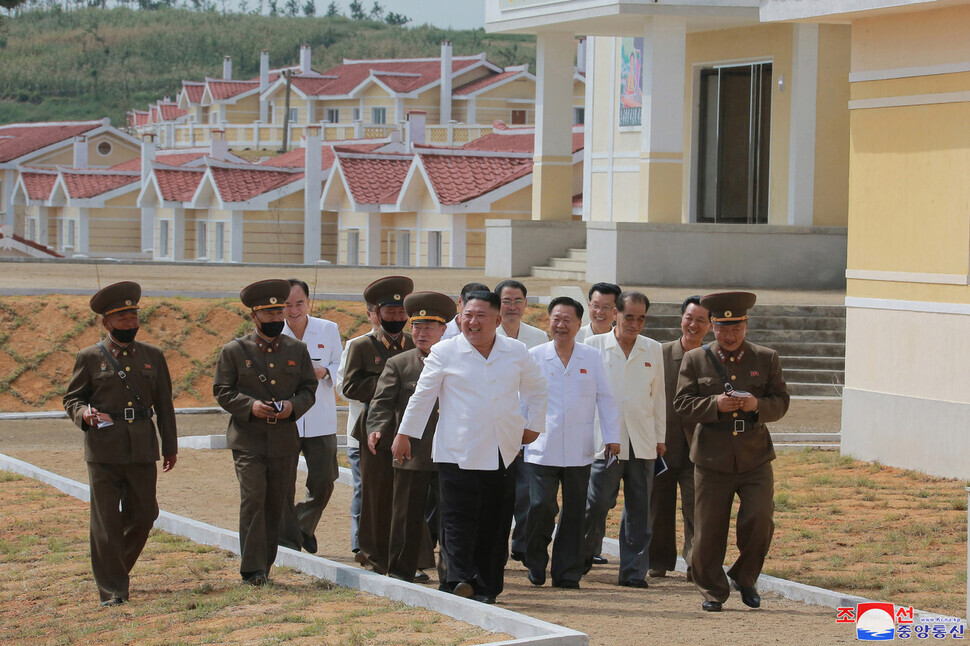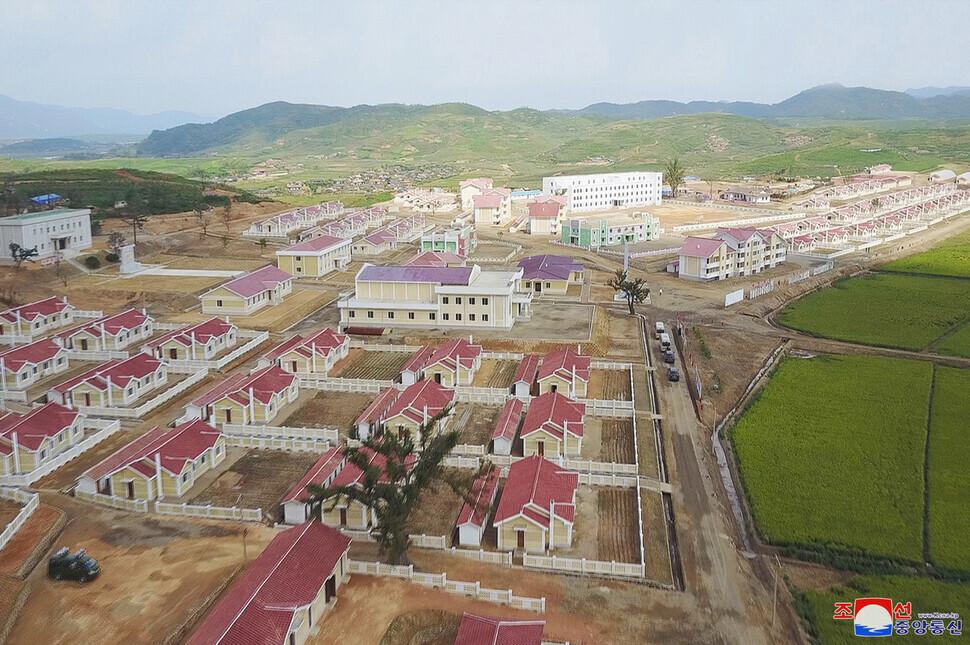hankyoreh
Links to other country sites 다른 나라 사이트 링크
Kim Jong-un visits village rebuilt by N. Korean army that was destroyed by floods and typhoon winds

In its Sept. 15 edition, the Rodong Sinmun devoted its entire front page to North Korean leader Kim Jong-un’s “on-the-spot guidance” at Kangbuk Village, Kumchon County, North Hwanghae Province, where efforts to repair damage from flash floods and strong winds had just concluded. Devastated by Typhoon Bavi and heavy rain last month, the village was the first place to be rebuilt by the Korean People’s Army (KPA), as the North Korean military is known, on orders from Kim.
The Rodong Sinmun reported that Kim had “wondered if the village which looked so pitiful for its backwardness plus damage [from the] natural disaster could shake them off in such a short period, adding he felt as if [he were] facing a different world.” Kim also expressed his “great satisfaction,” the state-run newspaper said. Photographs printed in the paper show 50 buildings of either one or two stories that had been newly erected in Kangbuk Village.
“The People’s Army is made up of creators of all miracles [in] this land,” Kim was quoted as saying. “It is the greatest pride of our Party and the state and the biggest blessing for [myself] that we have such [a] powerful [and loyal] revolutionary army.”

For the past month and a half, Kim has made five trips to areas damaged by the typhoons and floods, encouraging the recovery and underlining his attention to the public livelihood. Kim dispatched the KPA to repair damage and, when that proved inadequate, assembled a corps of 12,000 party members from Pyongyang who were assigned to the recovery work in Hamgyong Province. The Rodong Sinmun has been giving the story considerable attention, allotting half of the pages in its Tuesday edition to cheering on the recovery efforts.
There are several notable aspects of Kim Jong-un’s approach to “disaster recovery” politics. Most significantly, he initiated the recovery as soon as the damage occurred. Also notable is rebuilding damaged areas even better than before for use in public propaganda. Kim also rejected cooperation and assistance from the outside world — including South Korea — during the recovery, instead relying on a full mobilization of North Korea’s internal resources. In addition, Kim has placed a dramatic emphasis on the unity of the Workers’ Party of Korea (WPK) and the North Korean people. In an editorial, the Rodong Sinmun asserted that the WPK is “resolved and determined to create a miraculous opportunity for making good out of evil, even if that requires emptying the coffers of the state.”
Thus, Kim’s “disaster recovery politics” can be regarded as part of his crisis management, as he strives to hold the allegiance of a public that has been traumatized by the triple disaster of international sanctions, the COVID-19 pandemic, and destructive typhoons.
By Lee Je-hun, senior staff writer
Please direct comments or questions to [english@hani.co.kr]

Editorial・opinion
![[Column] When ‘fairness’ means hate and violence [Column] When ‘fairness’ means hate and violence](https://flexible.img.hani.co.kr/flexible/normal/500/300/imgdb/original/2024/0516/7417158465908824.jpg) [Column] When ‘fairness’ means hate and violence
[Column] When ‘fairness’ means hate and violence![[Editorial] Yoon must stop abusing authority to shield himself from investigation [Editorial] Yoon must stop abusing authority to shield himself from investigation](https://flexible.img.hani.co.kr/flexible/normal/500/300/imgdb/original/2024/0516/4417158464854198.jpg) [Editorial] Yoon must stop abusing authority to shield himself from investigation
[Editorial] Yoon must stop abusing authority to shield himself from investigation- [Column] US troop withdrawal from Korea could be the Acheson Line all over
- [Column] How to win back readers who’ve turned to YouTube for news
- [Column] Welcome to the president’s pity party
- [Editorial] Korea must respond firmly to Japan’s attempt to usurp Line
- [Editorial] Transfers of prosecutors investigating Korea’s first lady send chilling message
- [Column] Will Seoul’s ties with Moscow really recover on their own?
- [Column] Samsung’s ‘lost decade’ and Lee Jae-yong’s mismatched chopsticks
- [Correspondent’s column] The real reason the US is worried about Chinese ‘overcapacity’
Most viewed articles
- 1China calls US tariffs ‘madness,’ warns of full-on trade conflict
- 2[Column] US troop withdrawal from Korea could be the Acheson Line all over
- 3[Editorial] Yoon must stop abusing authority to shield himself from investigation
- 4[Column] When ‘fairness’ means hate and violence
- 5[Column] How to win back readers who’ve turned to YouTube for news
- 6US has always pulled troops from Korea unilaterally — is Yoon prepared for it to happen again?
- 7[Book review] Who said Asians can’t make some good trouble?
- 8Naver’s union calls for action from government over possible Japanese buyout of Line
- 9Could Korea’s Naver lose control of Line to Japan?
- 10[Editorial] Korea must respond firmly to Japan’s attempt to usurp Line